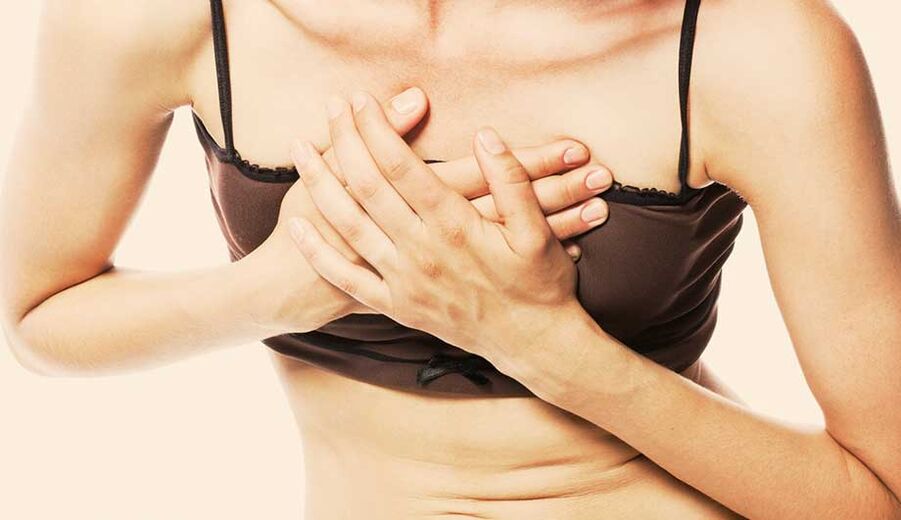Osteochondrosis is a very dangerous disease. It occurs imperceptibly, and from mild unpleasant sensations it grows into serious disorders of the spine, which sometimes result in disability.

Therapists, neurologists, orthopedists, vertebrologists and other specialists are involved in the treatment of this disease.
Symptoms and sensations of osteochondrosis in the chest
Osteochondrosis of the thoracic spine is less common than osteochondrosis of the cervical or lumbar spine. The thoracic vertebrae are less mobile and more protected. This disease is complicated by the fact that the symptoms are difficult to recognize, and after that it can lead to a number of other diseases.
One of the main reasons for the appearance of osteochondrosis of the thoracic region is the presence of scoliosis in humans. The curvature of the spine increases the pressure on the vertebrae and causes them to move and lose the discs from the spine. The pain that occurs with this disease is indicated by the fact that there are changes in the vertebrae, disturbance of metabolism and blood supply. This disease mainly affects people who lead an inactive life, office workers, drivers, students.
In thoracic osteochondrosis, the symptoms and feelings are divided into the main pain syndromes: dorsago and dorsalgia. Dorsalgia is a long-term chronic pain that is mild and brings little discomfort to the patient. Dorsago is a sudden, sharp pain. It occurs when a person is in a certain position for a long time and changes it dramatically. Shortness of breath may occur, breathing becomes difficult, muscles are poorly controlled.
Degenerative thoracic disc disease: symptoms and feelings are typical and atypical
Osteochondrosis of the thoracic region, like any other disease, has a number of characteristic features. List of typical symptoms:
- painful sensations are intensified when inhaling, turning the body, raising the arms up;
- the pain starts in one place and then spreads rapidly to the entire chest area. Shortness of breath. The patient is forced to seek a comfortable position. Intercostal neuralgia occurs;
- muscles are very tense, occasional spasms occur;
- precursors of intercostal neuralgia are recurrent pain, discomfort in the back and chest that occur when walking or exercising;
- the pain syndrome intensifies at night, it can be completely withdrawn by morning. It also becomes pronounced during hypothermia.
Osteochondrosis of the thoracic region is characterized by symptoms and feelings that are characteristic of other diseases. Such symptoms are called atypical. These include:
- painful sensations similar to diseases of the cardiovascular system. There is no improvement when taking the medication, and it can even worsen the health condition. Also, no changes are observed in the ECG;
- for women in the acute stage of disease development is characterized by mammary gland soreness. You can rule out this pathology by visiting a mammologist;
- sometimes patients complain of painful sensations similar to pain in gastritis, ulcers, diseases of the gastrointestinal tract. But, unlike these diseases, in osteochondrosis, the pain intensifies in moments of strong loads, and not during meals;
- disorders of the urinary and reproductive systems;
- some patients have difficulty in the swallowing reflex, feeling a "lump in the throat. "
Osteochondrosis of the chest requires immediate treatment, and self-medication is unacceptable. This can lead to worsening of the patient's condition and then to disability. Specialists can recognize typical and atypical symptoms of the disease. Qualified doctors diagnose thoracic osteochondrosis using modern equipment and treat them with the latest effective methods.
Chest osteochondrosis: symptoms and treatment
The hospital uses the best schemes and methods to treat osteochondrosis in the chest. The method of medication helps to eliminate the inflammatory process and relieve pain. The main method of dealing with osteochondrosis is the use of chondroprotectors over a long period of time. They restore the cartilage of the intervertebral discs, their elasticity. For hospital patients, a prerequisite for treatment is exercise therapy to strengthen the musculoskeletal framework. Muscle relaxants (relieve muscle cramps), nonsteroidal anti-inflammatory drugs are used.
To maintain overall balance, improve metabolism in the body, proper nutrition is essential. The hospital provides the services of nutritionists and inpatient wards, where it is much easier to maintain a healthy lifestyle during the recovery period than at home.
Additional treatment methods include:
- acupuncture;
- massages;
- physiotherapy;
- manual therapy;
- vacuum therapy.























